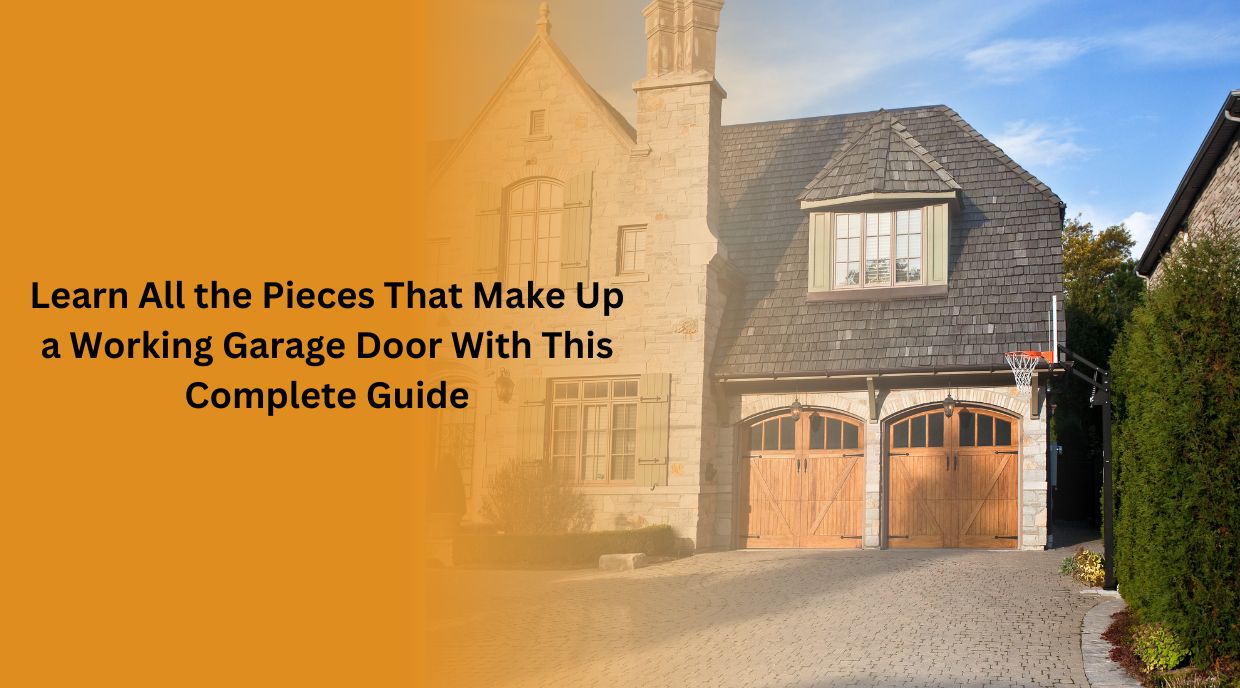Panels
The panels of a garage door are the largest and most noticeable components. They are available in a wide variety of materials and styles to match any home's decor, including steel, aluminum, wood, and fiberglass. The garage door is able to glide effortlessly over its rails thanks to the interconnected panels that are fastened together.
Springs
The springs on a garage door are what make it possible to open and close the door, whether by hand or with a motorized opener. Garage doors typically use either torsion springs or extension springs for their mechanisms. Above the door, a set of torsion springs uses torque to help lift it, while on either side of the door, a pair of extension springs stretches to provide the necessary force.
Tracks and Rollers
The garage door is guided by a system of rails and rollers. They make the opening and closing of the door effortless and accurate. The tracks are often installed on the garage's walls or ceiling and are composed of galvanized steel. Attached to the edges of the door panels are rollers, often composed of steel or nylon, that roll effortlessly down the rails.
Hinges

The hinges of a garage door are the joints that hold the door panels together. They allow the door to flex while opening and closing, making the process more easier. Most garage doors have several hinges spaced evenly along the panels so that they can be folded and unfolded repeatedly without breaking or cracking.
Cables and Drums

The garage door is lifted and lowered with the use of springs, cables, drums, and drum motors. The cables attach to the bottom of the door and loop around drums above the roller tracks. When the door is raised or lowered, tension is created by winding or unwinding the cables from the drums.
Opener

An electric motorized gadget, the garage door opener makes it easy to open and close the door without getting your hands dirty. A remote or a wall-mounted switch is usually used to operate it. The opener is attached to the door's mechanism by a drive system (belt, chain, or screw) and supplies the necessary power to open and close the door.
Both homeowners and repairmen need an understanding of what goes into a garage door. From the door panels and springs to the door tracks and opener, every component is essential to the garage door's proper functioning. These parts need to be maintained and repaired on a regular basis to ensure that they last a long time and continue to perform properly. Getting to know these garage door components can help you deal with potential problems and make educated choices about fixes and upgrades.
A Comprehensive Guide to Garage Door Materials
The longevity, ease of upkeep, aesthetic appeal, and overall cost of ownership of your garage door all depend on the material you choose. Choosing the perfect material for your specific needs and preferences might be difficult when so many options exist. Different garage doors can be made from a variety of materials, each with its own advantages and disadvantages.
Steel
Steel is widely used as a garage door material because of its longevity and adaptability. It can survive high winds and other severe conditions, earning it a reputation for durability. You can paint a steel door to make it blend in with the rest of your home's exterior because most steel doors are galvanized to prevent rusting.
Pros: it lasts a long time, requires little care, and is cheap.
Cons: Dents and scratches are possible, and low-quality steel will corrode over time.
Wood
Wooden garage doors are unrivaled in their beauty. Homeowners seeking a classic or rustic aesthetic often choose them due to their wide availability in design and finish options. Doors constructed of wood can be made from a variety of materials, such as cedar, redwood, or mahogany.
Pros: It's attractive, you may alter it to your liking, and it provides good insulation.
Cons: more expensive than alternative materials and needs frequent care to avoid warping and rotting.
Aluminum
The advantages of aluminum garage doors over steel doors include their lower weight and resistance to rust. You can get them in a wood-look finish or have them painted to match your interior.
Pros: It's easy to maintain, doesn't rust, and doesn't weigh much.
Cons: Dents and scratches show up more easily than with steel.
Vinyl
Vinyl garage doors are an excellent alternative for those who want a low-maintenance door. In addition to neither rusting or rotting, they are also dent-proof. In addition, they are accessible in a wide range of hues and designs.
Pros: Long-lasting, resistant to dents and corrosion, and easy to maintain.
Cons: Not a lot of pattern and color options, and they wear out quickly.
Fiberglass
Garage doors made of fiberglass are a recent innovation. They're easy to transport and can be made to seem like wood or other materials. Fiberglass entry doors are more resilient to salt air and sand than steel ones are.
Pros: It's lightweight, has a flexible construction, and won't rust.
Cons: Less energy efficient than alternative materials; can crack in sub-zero temperatures.
Composite Wood
Composite wood garage doors are an excellent option if you want the natural look of wood without the hassle. They are resistant to rot and cracking since they are fabricated from recycled wood fibers. Doors made of composite wood can be stained or painted to suit your aesthetic preferences.
Pros: include adaptability, durability against decay and cracking, and minimal upkeep.
Cons: Higher cost compared to steel or vinyl.
Selecting the Right Material
It's important to think about cost, location, and aesthetics when deciding on a garage door material. Fiberglass or aluminum, which won't rust, are wonderful options if you happen to reside near the water. Wood doors are a good option if you value tradition and are ready to put in the necessary care and cleaning.
Keep in mind that a well-chosen garage door may do wonders for the aesthetics, value, and efficiency of your property. If you want advice tailored to your individual garage door needs and preferences, talk to an expert.
In conclusion, garage door materials come in a broad range, each with its own set of pros and cons. By learning about these, you'll be able to pick the ideal garage door material for your house.
Garage Door Repair Services Near Aliso Viejo, CA
You, as a resident of Aliso Viejo, California, know how crucial it is to have a garage door that works well and can be relied upon. A well-maintained garage door is essential for safety, convenience, and aesthetic reasons. Quick, efficient, and trustworthy service is essential when your garage door requires fixing. The best garage door repair companies in the areas surrounding Aliso Viejo, California, are profiled below.
Garage Door Brands: A Comprehensive Overview of Clopay, Stanley, Genie, Linear, and Wayne Dalton
An attractive, functional, and secure garage door is a must-have for any house. When deciding on a garage door, it's important to look for a name brand that you know you can trust. Five well-known manufacturers of garage doors—Cloway, Stanley, Genie, Linear, and Wayne Dalton—will be discussed in detail below. Let's check out what sets each label apart from the rest.

Clopay
In terms of garage doors, Clopay is a household name. After more than half a century in business, Clopay has earned a stellar reputation for producing sturdy, well-designed doors. Their extensive catalog of commercial and residential doors meets the needs of a wide variety of building designs and individual tastes. Energy efficiency, noise reduction, and greater insulation are just a few of the reasons why Clopay doors are a top pick for homeowners.

Genie
Genie is a name that stands out among garage door opener manufacturers. Genie has changed the game when it comes to operating and opening garage doors by prioritizing user friendliness and ease. Advanced technologies like smartphone compatibility, backup batteries, and silent operation are built into Genie openers. The company manufactures numerous opener variants to suit a variety of door widths and thicknesses. Genie has built a dedicated consumer base thanks to their cutting-edge technologies and user-friendly products.

Wayne Dalton
When people think of quality and craftsmanship, they think of Wayne Dalton. Since its founding in 1954, Wayne Dalton has been an industry leader in garage door technology. The longevity, insulation, and adaptability of their doors have earned them widespread acclaim. Doors are an important part of any building, and Wayne Dalton has many options for you to choose from. Wayne Dalton has become a household name thanks to their dedication to providing excellent service and exceeding customer expectations.

Raynor
For nearly seven decades, Raynor has led the garage door industry with reliable, cutting-edge products and services. The products are well-known for their high quality, durability, and efficiency. Raynor provides a wide selection of commercial and residential garage doors that are both sturdy and aesthetically pleasing. Their doors are equipped with cutting-edge safety features, energy saving features, and noise canceling technology to provide superior performance and comfort for homes. Raynor has remained a go-to for picky shoppers thanks to their dedication to quality manufacturing and service.

LiftMaster
LiftMaster is a renowned brand that specializes in garage door openers, making it an ideal choice for those seeking reliable and efficient access solutions. LiftMaster's openers are recognized for their cutting-edge technology, superior performance, and durability. With features such as MyQ connectivity, battery backup, and smart home integration, LiftMaster empowers homeowners to control and monitor their garage doors conveniently. The brand offers a wide range of opener models to accommodate different door sizes and types, ensuring compatibility with various garage door configurations. LiftMaster's commitment to quality and innovation has solidified its position as a leading provider of garage door openers.
Image from Freepik
 (949) 776-2375
(949) 776-2375